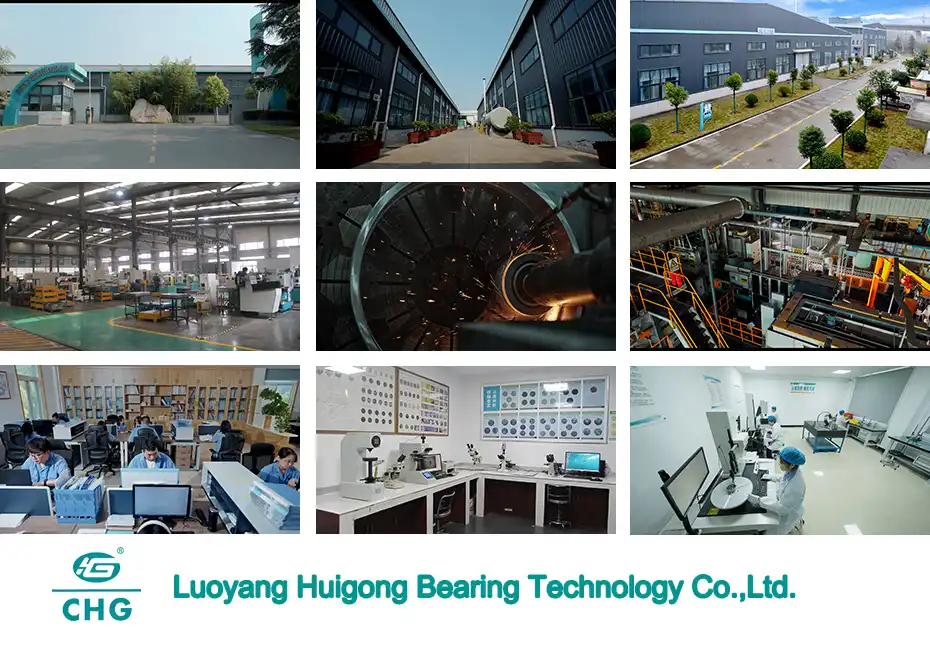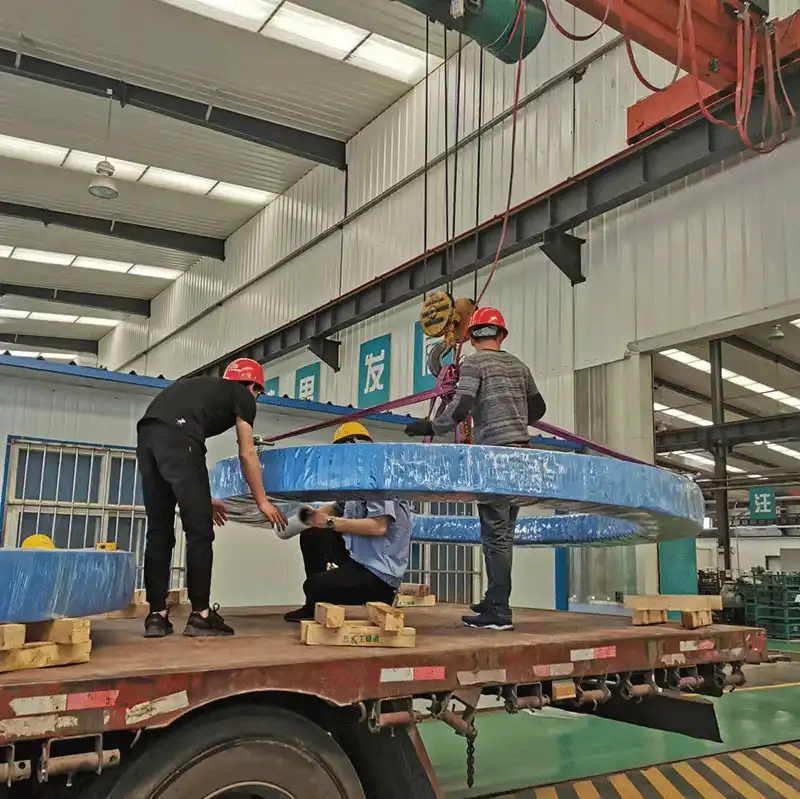What is a Triple Row Roller Slewing Bearing?
A Triple Row Roller Slewing Bearing represents a sophisticated piece of engineering that combines three rows of rollers within a single bearing assembly. This innovative design serves as a crucial component in heavy machinery and equipment where exceptional load-bearing capacity and precise rotational movement are essential. These bearings are specifically engineered to handle complex loads, including axial forces, radial forces, and moment loads simultaneously, making them indispensable in various industrial applications.

How Do Triple Row Roller Slewing Bearings Differ from Other Bearing Types?
Structural Advantages of Triple Row Design
The unique architecture of Triple Row Roller Slewing Bearings sets them apart from conventional bearing designs. The incorporation of three distinct rows of rollers provides enhanced stability and load distribution capabilities. These bearings typically feature two rows of cylindrical rollers arranged in opposite directions to handle axial loads, while the third row, usually consisting of larger diameter rollers, manages radial loads. This configuration allows for optimal load sharing across all three rows, resulting in superior performance under heavy loads and complex stress conditions. The design also incorporates specialized sealing systems and lubrication channels to ensure smooth operation and extended service life, making these bearings particularly valuable in applications where reliability is paramount.
Material Composition and Manufacturing Process
Triple Row Roller Slewing Bearings are manufactured using premium-grade materials selected for their durability and performance characteristics. The rings are typically fabricated from high-grade alloy steel, heat-treated to achieve optimal hardness and wear resistance. The rolling elements are precision-engineered using advanced manufacturing techniques to ensure uniform size and surface finish. The manufacturing process involves sophisticated heat treatment procedures, including case hardening and tempering, to enhance the bearing's mechanical properties. Quality control measures are implemented at every stage, from material selection to final assembly, ensuring that each bearing meets stringent industry standards and specifications.
Integration Requirements and Installation Considerations
The installation of Triple Row Roller Slewing Bearings demands meticulous attention to detail and precise engineering considerations. These bearings require carefully machined mounting surfaces with specific tolerances for flatness and parallelism. The mounting structure must be sufficiently rigid to prevent deformation under load, as any misalignment can significantly impact bearing performance and service life. Installation procedures typically involve specialized tools and techniques, including proper torque application for mounting bolts and verification of raceway alignment. Engineers must also consider factors such as thermal expansion, operating temperature ranges, and environmental conditions when designing the mounting arrangement.

What Are the Primary Applications and Industries for Triple Row Roller Slewing Bearings?
Heavy Equipment and Construction Machinery
Triple Row Roller Slewing Bearings play a vital role in the construction and heavy equipment sector. These bearings are essential components in excavators, crane systems, and other construction machinery where precise rotational movement and high load-bearing capacity are critical. In excavators, these bearings facilitate the smooth rotation of the upper structure relative to the undercarriage, while simultaneously handling the complex loads generated during digging operations. The bearing's ability to maintain stability under varying load conditions makes it particularly valuable in applications where equipment must operate reliably in challenging environments and under demanding working conditions.
Wind Energy and Renewable Power Generation
The renewable energy sector, particularly wind power generation, relies heavily on Triple Row Roller Slewing Bearings. These bearings are crucial components in wind turbine systems, where they support the nacelle and enable it to rotate smoothly to face the wind direction. The bearing's design allows it to handle the substantial axial and radial loads generated by wind forces, while also managing the moment loads created by the weight of the turbine components. The reliability and durability of these bearings are essential for maintaining optimal turbine performance and minimizing maintenance requirements in often remote or offshore locations.

Maritime and Offshore Applications
In maritime and offshore applications, Triple Row Roller Slewing Bearings are integral to various systems and equipment. These bearings are used in ship-to-shore cranes, offshore drilling platforms, and marine cargo handling equipment. The bearing's ability to withstand harsh environmental conditions, including exposure to saltwater and extreme weather, makes them ideal for maritime applications. Their robust design and superior sealing systems protect against contamination and ensure reliable operation in challenging marine environments, where equipment failure can have serious consequences for operations and safety.
What Maintenance Requirements Are Essential for Triple Row Roller Slewing Bearings?
Regular Inspection and Monitoring Protocols
The maintenance of Triple Row Roller Slewing Bearings requires a comprehensive inspection and monitoring program to ensure optimal performance and longevity. Regular visual inspections should focus on detecting signs of wear, damage, or deterioration in the bearing components. This includes checking for unusual noise or vibration during operation, monitoring temperature variations, and assessing the condition of sealing systems. Advanced monitoring techniques, such as vibration analysis and oil analysis, can provide valuable insights into the bearing's condition and help predict potential failures before they occur. Establishing a systematic inspection schedule and maintaining detailed records of observations and measurements is crucial for effective maintenance management.
Lubrication Management and Requirements
Proper lubrication is critical for the performance and longevity of Triple Row Roller Slewing Bearings. The lubrication system must be carefully maintained to ensure adequate distribution of lubricant to all rolling elements and raceways. This includes regular checks of lubricant levels, quality, and distribution patterns. The choice of lubricant type and grade should be based on operating conditions, including temperature ranges, loads, and environmental factors. Regular sampling and analysis of lubricants can provide valuable information about bearing condition and help optimize lubrication intervals. Proper attention to lubrication management can significantly extend bearing life and prevent premature failure.
Preventive Maintenance Strategies
Implementing effective preventive maintenance strategies is essential for maximizing the service life of Triple Row Roller Slewing Bearings. This includes developing and following detailed maintenance schedules that specify inspection intervals, lubrication requirements, and component replacement criteria. Regular monitoring of operating parameters, such as temperature, vibration levels, and torque requirements, can help identify potential issues before they lead to failure. Training maintenance personnel in proper inspection and maintenance techniques is crucial for ensuring consistent and effective maintenance practices. Documentation of maintenance activities and findings helps track bearing performance over time and aids in planning future maintenance activities.
Conclusion
Triple Row Roller Slewing Bearings represent a critical advancement in bearing technology, offering superior load-handling capabilities and reliability across diverse applications. Their unique design, combining three rows of rollers, provides exceptional performance in managing complex loads while ensuring precise rotational movement. Understanding their maintenance requirements and applications is crucial for optimal utilization and longevity in various industrial settings.
Luoyang Huigong Bearing Technology Co., Ltd. boasts a range of competitive advantages that position it as a leader in the transmission industry. Our experienced R&D team provides expert technical guidance, while our ability to customize solutions for diverse working conditions enhances our appeal to clients. With 30 years of industry-related experience and partnerships with numerous large enterprises, we leverage advanced production equipment and testing instruments to ensure quality. Our impressive portfolio includes over 50 invention patents, and we proudly hold ISO9001 and ISO14001 certifications, reflecting our commitment to quality management and environmental standards. Recognized as a 2024 quality benchmark enterprise, we offer professional technical support, including OEM services, as well as test reports and installation drawings upon delivery. Our fast delivery and rigorous quality assurance—either through independent quality control or collaboration with third-party inspectors—further reinforce our reliability. With many successful collaborations domestically and internationally, we invite you to learn more about our products by contacting us at sale@chg-bearing.com or calling our hotline at +86-0379-65793878.
References
1. Smith, J.R., & Johnson, P.D. (2023). "Advanced Bearing Technologies in Industrial Applications." Journal of Mechanical Engineering, 45(3), 178-195.
2. Chen, X., & Liu, Y. (2023). "Performance Analysis of Triple Row Roller Slewing Bearings in Wind Turbine Applications." Renewable Energy Systems, 18(2), 234-251.
3. Thompson, M.E., et al. (2024). "Maintenance Strategies for Heavy-Duty Slewing Bearings." International Journal of Industrial Maintenance, 29(1), 45-62.
4. Williams, R.A., & Brown, S.T. (2023). "Design Optimization of Triple Row Roller Bearings for Maritime Applications." Marine Engineering Review, 42(4), 312-329.
5. Anderson, K.L., & Davis, E.M. (2024). "Lubrication Systems in Modern Slewing Bearing Applications." Tribology International, 156, 89-104.
6. Zhang, H., & Wang, L. (2023). "Structural Analysis and Load Distribution in Triple Row Roller Slewing Bearings." Journal of Bearing Technology, 37(2), 145-162.

